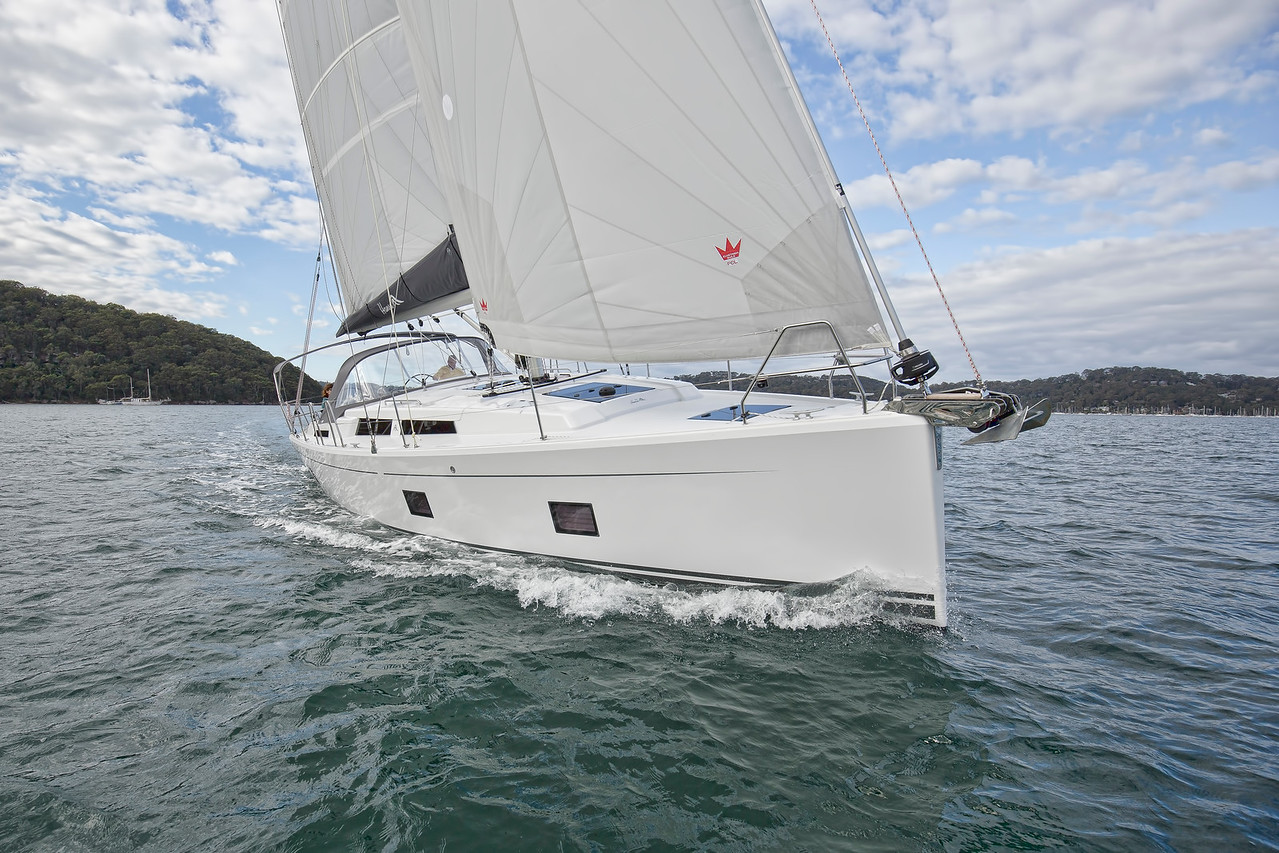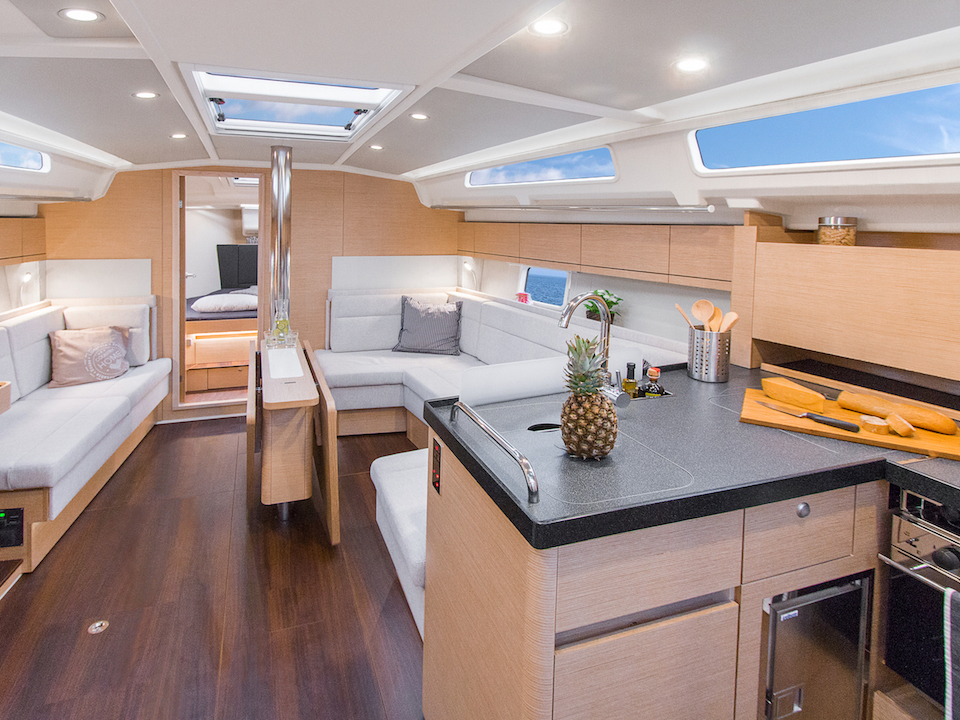Precision fun
Hanse’s 418 is a template for enjoyable sailing: light and manageable, yet still powerful. And as we found out, it’s also a whole lot of fun and comes with a host of welcome extras.
Photography by Beth Morley
07 August 2018
Advertisement
There is always a moment offshore when the first decent ocean swell gathers itself before you and the boat begins to react. What happens next is a confidence clincher.
Given you have the correct sail-plan, the boat should track truly up the face, hold her line over the crest and slide down the other side.
Alternatively, as you come off the top, there might be a disconcerting crash followed by various creaking and groaning protests; an indication your ride is probably better suited to other things. If that happens, you are in a for a long day, or night, and better think about prudent boat and crew management.
Hanse’s 418 is unequivocally in the first category. Competent, smooth and assured, it is a delight to steer.
As we poked out from under Barrenjoey Head into the first two-and-a-half-metre Tasman speculator, the 418’s pedigree was obvious. With its straight stem, the Judel/Vrolijk design sliced cleanly through the confused seaway. The 418 then rode up the wave, powered over the crest and handled the exit with aplomb.
Advertisement
I was downstairs on purpose to check the dismount and there was … near silence. Just a slight rearranging of crockery in their secure drawers. Very impressive.
There are very good reasons why this is the case. First, there’s a special, extra-robust polyester bonding for the hull/deck connection. Then there’s the keel plates. Laid into a bed of ultra-strong epoxy resin in the bottom of the hull, they’re surrounded by a structural grid.
The keel bolts, nuts and washers are all stainless steel, and high-strength bolts are employed in the cleats. Finally, the hull itself is a balsa-cored, fibreglass sandwich laminate. Set in polyester resin, its exterior layer is set in vinylester for improved osmosis resistance.
It all combines to form an extremely strong, stiff boat that inspires confidence in challenging conditions.
The L-shaped keel – slightly re-worked for better performance – contributes to the 418’s beautifully nimble feel. It turns superbly, which makes tacking a pleasure, and is back in the groove quickly thanks to Hanse’s signature self-tacking genoa.
By the numbers, in 14 knots of true wind, a recommended optimum 41-degree wind angle delivers seven knots of boat speed. Cracking the Elvstrom FCL sails to a reach, the boat quickly accelerated to a tick over eight.
Windcraft Yachts, who have been bringing the highly regarded Hanse brand into Australia for nearly two decades, offer a North gennaker for running downwind at more than 110 degrees. There’s also the option of an asymmetric spinnaker. Either would comfortably send the easily driven hull into double digits in favourable conditions, backing up the claims that the 418 is one of the best performers in the crowded 40- to 45-foot production yacht segment.
Quite the bonus. Whether in relaxed cruising mode or in the midst of a bunch of regatta tragics, the boat is deceptively quick.
Too easy
It’s been a while since I’ve been on a Hanse, but once again I was struck by just how easy it is to go sailing. My hosts for the day – Mary Bickley and Ric Hawkins – handled everything from the helm.
The perfectly functional 39hp Yanmar pushed the 418 along fine, but when the time came to kill the donk, the main halyard was hoisted hassle free straight out of its bag and the jib unfurled shortly after. Both main and jib sheets are controlled by push-button, electric helm winches from Lewmar; absolutely ideal for a couple or short-handed cruising.
The owners of Breathe, the very well-appointed 418 we tested, have chosen the popular option of two forward manual Lewmar winches for a gennaker or kite; the best way to make easy miles on a boat as well-balanced and agreeable to helm as this.
The B&G instrument display and autopilot is right next to the slick, black-composite Jefa wheels (a tribute to Danish precision). The comprehensive instrument package also includes a B&G 9-inch Zeus chart plotter with AIS in a console attached to the high-gloss teak cockpit table.
The table is a nice touch from Windcraft. With local shipwrights applying the finish over ten days, it is the sort of detailing that befits this fine example of quality boatbuilding. So too do the other cockpit appointments such as folding helm seats and the generous swim platform that you can laze on after a dip, or tether a few kayaks or stand-up paddleboards to. Meanwhile, with the platform lowered, the whole cockpit space opens up for dining and entertaining; the cockpit seat cushions even have backrests.
It’s all about the details and the options. From the fridge that can be fitted in to the cockpit table to synthetic teak side decks, which are lighter and less maintenance than the real thing, there are also four different styles of furniture, floorboards and upholstery to choose from. The degree of customisation is incredible; right down to the cushion choices.
In this case, the French oak joinery complements the understated Florence lounge upholstery and classic stripe floorboards.
Designed to please
Designers have been constantly expanding the parameters of light and space in recent years, and the 418 represents just how far we’ve progressed from the dark, claustrophobic saloons of a few decades ago.
Glass is now incorporated as a structural element in the hull and is utilised to great effect in the companionway panels. Complemented by a large saloon hatch and skylight, the interior is flooded with light. Similarly, the most has also been made of the boat’s 4.17 beam, which is carried nearly all the way aft.
The 418 is based on the highly successful 415 model, of which Windcraft have sold 27 hulls. The main differences between the two are, in fact, in the interior; but they’re substantial.
A new deck moulding provides more height and width in the galley and bathroom, which is spacious enough to accommodate a head and full-size shower with a foldable screen that is held firmly in place by a smart bolt arrangement. There’s no clanging when at sea here.
Buyers have a choice between two- or three-cabin layouts. Breathe is the former, featuring substantial under-cockpit storage on the starboard side for longer trips, with entry from either the cockpit or a door in the galley, as well as a longer galley bench.
The extremely comfortable owners’ cabin in the bow is a major drawcard. The siting of the bed forward makes access easier and creates extra width. This allows for a luxurious head-to-bow sleeping arrangement, which is not usually possible on a yacht this size. The large hull windows offer great views from the bed too.
The owners, long-time sailors, opted for a slide-out double berth in the saloon to boost extra overnight accommodation. The chart table to port can be lowered to configure another berth or extend the sofa. Each of the LED lights has a USB charger in its base; a simple but effective solution to incessant charging requirements.
The saloon table – a double leaf, fold-out arrangement – will seat up to seven for dinner. A handy pull-out wine rack slides from the table’s centre console, with more wine (or just bottle) storage in a rack under the cabin floor. The L-shaped galley has good bench space and storage lockers, with handy grab rails for rough conditions.
The electric fridge has dual access (bench .
top as well as a lower, front door), while the two-burner gas cooker is complemented with an oven. A medium-sized gas bottle lives in a rear, self-draining cockpit locker while the 475-litre water tank is big enough for the extended coastal runs that Breathe’s owners are planning.
Made for the future
Hanse’s design philosophy, which employs the luxury and standard of finish of its larger vessels across the range to its smallest boats, is realised in the brand’s new 8 series. The 418 is the middle of the sequence that starts with the 348 and runs through to the 588.
Each model combines elegant lines and easy sailing characteristics with superior levels of comfort. It’s interesting to note that while many companies have switched to twin-rudder boats with chined hulls, Hanse has opted to stay with single rudders and no chines. As a result, in my opinion, the boats are better all-round performing hulls than many of their counterparts.
The company is also investing heavily in the future and will soon add two sensational new models, the 458 and the 508. A number of very cool design ideas have been incorporated into these latest additions to the 8 line.
The 458’s main bulkhead is a composite construction with carbon reinforcement, which provides a stiff and direct mast-keel connection. This makes the interior even larger with its loft-like design exploited to its full advantage. The 458 also gains ergonomic plotter pods, a double anchor arm for a code zero and six windows in the aft cabins. It will be offered in the owner’s version with a large master cabin in the bow or with four double cabins for more guests on board.
Meanwhile, the 508 features the kind of push-button technology that has only become available over the past few years. This is teamed with long-distance, blue-water sailing intent, which is evidenced by an inner forestay and the option of a big utility workroom.
Overall, Hanse’s new 8 series has set the bar extremely high in terms of quality, performance and comfort in a production yacht. Buyers have an unparalleled array of choices to match both their desires and their sailing aspirations. All of which is informed by Hanse’s deep knowledge of – and respect for – the sea.
Advertisement
Advertisement
Advertisement




